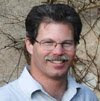Two of the most distinctive elements of this piece's design are the sculpted bonnet and base. Both are made of wenge, a dark, dense, black/brown wood, that will give weight to and ground the piece. Both are stack laminated and then shaped. This series of photos shows the steps involved in making the bonnet:
First, pieces are face-laminated to achieve the required thickness for shaping. In this case, to accommodate the width of the part, it was made in three sections and then glued together after shaping (you can see the mortises for the floating tenons that will help with both alignment and glue joint strength) ....




Next, the built up blanks are rough cut to shape on the band saw....

Finally, the subparts are glued together and the entire piece is shaped ....

The base was created in much the same way, with the pieces in each layer being bandsawn roughly to size before glue-up, then the whole part being shaped afterward ....








